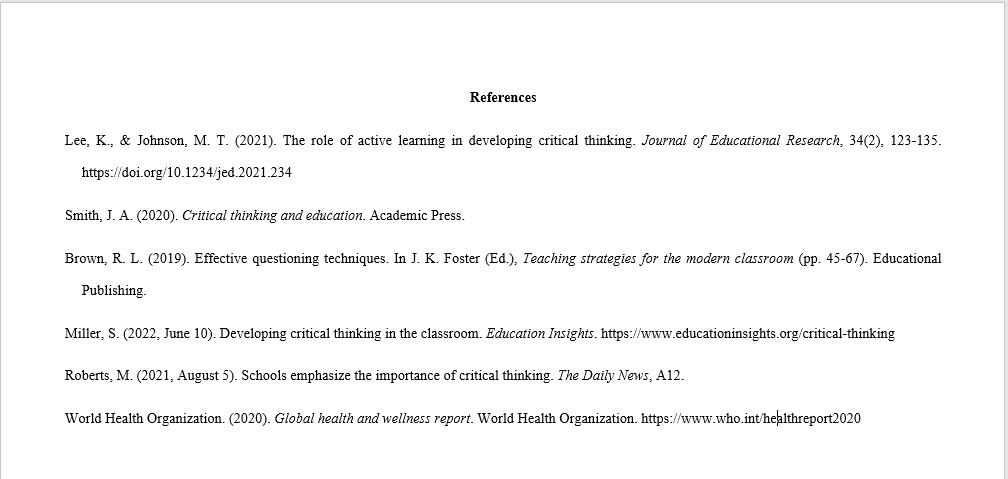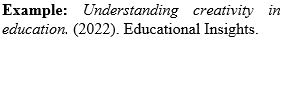
The American Psychological Association (APA) reference style is one of the most widely used citation styles, especially in social sciences, education, and psychology. Using APA style helps researchers and students present their work consistently, credit original authors, and allow readers to verify sources. Mastering APA style requires understanding both in-text citations and the format for a References page. Here’s a guide with examples to help you use APA reference style properly.
In APA style, in-text citations include the author’s last name, the publication year, and sometimes the page number. These citations are placed in the body of the text whenever you quote, paraphrase, or refer to ideas from another source. There are two formats for in-text citations: parenthetical and narrative.
Parenthetical Citation
In a parenthetical citation, both the author’s last name and the publication year appear in parentheses.
Example:
Research shows that “students’ critical thinking skills improve with structured learning activities” (Smith, 2020, p. 45).
Narrative Citation
In a narrative citation, the author’s name is integrated into the sentence, followed by the publication year in parentheses (p. 45).
Example:
According to Smith (2020), “students’ critical thinking skills improve with structured learning activities”.
Note:
If you’re summarizing a source and not including a direct quote, the page number is optional. For example, “Smith (2020) highlights the importance of structured activities in critical thinking.”
The References page is where you list all sources cited in your paper, arranged alphabetically by the authors’ last names. Each entry should have specific elements depending on the type of source. Here’s the basic structure for different sources:

For
Format
Example
Author, A. A., & Author, B. B. (Year). Title of the article. Title of the Journal, volume(issue), page range. https://doi.org/xxxxxx

Author, A. A. (Year). Title of the book. Publisher.

Edited Book Chapter
Author, A. A. (Year, Month Day). Title of the webpage. Website Name. URL


Newspaper Article
Author, A. A. (Year, Month Day). Title of the article. Newspaper Title, page(s).

Report from an Organization
Author, A. A. (Year, Month Day). Title of the article. Newspaper Title, page(s).

Use double spacing throughout the References page.
Authors
What to do
Example





Research Paper Plagiarism Removal Services
Research Paper Plagiarism Checking Services
Drillbit Plagiarism Checking Service
Review Paper Plagiarism Removal Services
Review Paper Plagiarism Checking Services
Turnitin Plagiarism Checking Service
Thesis Plagiarism Removal Services
Thesis Plagiarism Checking Services
Urkund Plagiarism Checking Service
Dissertation Plagiarism Removal Services
Dissertation Plagiarism Checking Services
Grammarly Plagiarism Checking Service
M. Tech Dissertation Plagiarism Removal Services
M. Tech Dissertation Plagiarism Checking Services
viper Plagiarism Checking Service
PhD Thesis Plagiarism Removal Services
PhD Thesis Plagiarism Checking Services
Plagiarism Checker X Plagiarism Checking Service
Medical Research Plagiarism Removal Services
Medical Research Plagiarism Checking Services
iThenticate Plagiarism Checking Service
Funded Project Plagiarism Removal Services
Funded Project Plagiarism Checking Services
Quillbot Plagiarism Checking Service
Research Project Plagiarism Removal Services
Research Project Plagiarism Checking Services
WhiteSmoke Plagiarism Checking Service
DST Project Plagiarism Removal Services
DST Project Plagiarism Checking Services
QueText Plagiarism Checking Service
ICMR Project Plagiarism Removal Services
ICMR Project Plagiarism Checking Services
Copyleaks Plagiarism Checking Service
AICTE Project Plagiarism Removal Services
AICTE Project Plagiarism Checking Services
Copyscape Plagiarism Checking Service
SEO Plagiarism Removal Services
SEO Plagiarism Checking Services
BibMe Plagiarism Checking Service
Blog Plagiarism Removal Services
Blog Plagiarism Checking Services
PrePostSEO Plagiarism Checking Service
Website Plagiarism Removal Services
Website Plagiarism Checking Services
Plagly Plagiarism Checking Service
Content Plagiarism Removal Services
Content Plagiarism Checking Services
PaperRater
Online Plagiarism Removal Services
Online Plagiarism Checking Services
Plagramme
Talk with Plagiarism Expert